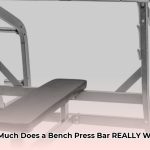Knowing a barbell’s weight is crucial for tracking progress and lifting safely. This guide covers everything from standard barbell weights to variations, factors affecting weight, and how to choose the right bar for your needs.
Standard Barbell Weight: The Foundation
The most common barbell you’ll encounter is the standard Olympic barbell. This workhorse weighs 45 pounds (20kg) and is 7 feet long with a 2-inch diameter. This weight is the baseline for most exercises, so knowing it is fundamental for calculating your total lifted weight. For example, 135 lbs on the bar means you’re lifting 180 lbs total (including the bar itself).
Barbell Variations: A Diverse Ecosystem
While the 45-pound Olympic barbell is the standard, there’s a whole world of barbells out there, each designed with specific purposes in mind.
Barbell Weight Chart
| Barbell Type | Weight Range (lbs) | Length (ft) | Diameter (in) | Notes |
|---|---|---|---|---|
| Standard Olympic (Men’s) | 45 | 7 | 2 | The gym’s workhorse, great for all-around use. |
| Standard Olympic (Women’s) | 35 | 6.5 | 1.125 | Slightly lighter and thinner, often preferred by those with smaller hands. |
| Technique Bar | ~15 | 6-7 | Varies | Lighter for practice and perfecting form; builds good habits before heavier lifts. |
| Safety Squat Bar | ~60-70 | 7 | Varies | Unique shape distributes weight differently for squats; can be more comfortable. |
| Trap Bar/Hex Bar | ~45-70 | Varies | Varies | Hexagonal shape; allows lifter to stand inside, engaging different muscles. |
| Powerlifting Bar | 45 | 7 | 2.2 | Designed for maximal stiffness to handle very heavy loads in powerlifting. |
What Influences Barbell Weight?
Several factors contribute to a barbell’s weight:
- Material: Most barbells are made of steel, but the specific alloy can influence density and therefore weight. Some specialty bars use denser materials, significantly increasing their weight.
- Length: Longer bars will naturally weigh more than shorter bars, assuming similar thickness and material.
- Diameter/Thickness: A thicker bar uses more material, resulting in a heavier bar. This also affects grip.
- Knurling: The textured grip on a barbell adds a negligible amount of weight.
- Sleeves: The rotating sleeves on Olympic barbells add some weight, but their primary function is to allow plates to spin freely, reducing wrist strain during dynamic lifts.
How to Determine Your Barbell’s Weight
- Check for Markings: Most barbells have their weight stamped or etched on the bar.
- Consult the Manufacturer: Check the manufacturer’s website or documentation.
- Use a Scale: The most accurate method is to weigh the barbell.
Choosing the Right Barbell Weight
Selecting the right barbell weight depends on several factors:
- Experience Level: Beginners should start with lighter weights, potentially just the bar itself, focusing on proper form. More experienced lifters can progressively increase the weight.
- Training Goals: Different barbells are suited for different training styles. Powerlifters might prefer stiffer bars, while Olympic lifters need rotating sleeves.
- Comfort: Grip diameter and overall bar weight can affect comfort, particularly for those with smaller hands.
Finding Your Starting Weight for Lifts
Determining how much weight to add to the barbell for exercises like the chest press (bench press) depends on individual factors:
- Training Age: How long have you been lifting?
- Current Strength Level: What’s your estimated one-rep max (1RM)?
- Gender & Bodyweight: These can influence strength potential, although individual variation is significant.
- Overall Fitness Level: Factors like general health and activity level can impact your starting point.
Resources like Strength Level offer average 1RM data based on gender, but remember these are just averages. Consult a fitness professional for personalized guidance.
Barbell Safety: Essential Practices
- Use Collars: Secure weight plates to prevent them from sliding off.
- Balanced Loading: Load plates evenly on each side to maintain balance.
- Spotters: Use a spotter for heavy lifts, especially bench presses.
- Proper Form: Prioritize good form over heavy weight to prevent injuries.
Conclusion: Lift Smart, Lift Safe
By understanding barbell weights, variations, and safety practices, you can optimize your training for better results and a safer lifting experience. Remember, consistent effort and proper technique are key to long-term progress.
- Affordable Employee Wellness Fair Ideas for Any Budget - December 14, 2025
- Employee Wellness Programs Strategically Benefit Employee Health And Retention - December 13, 2025
- Health and Wellbeing Companies Driving Employee Engagement and Productivity - December 13, 2025
















